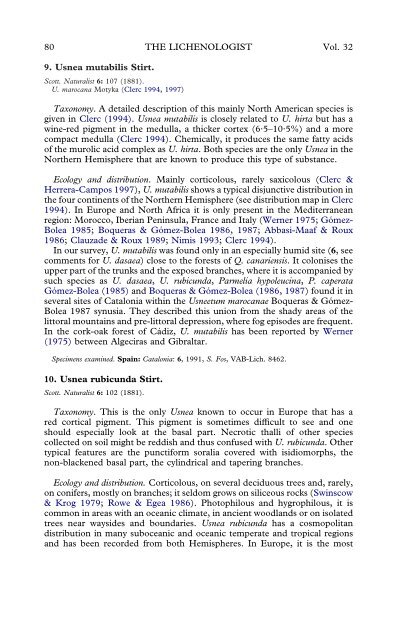the lichen genus usnea on quercus suber in iberian cork-oak forests
the lichen genus usnea on quercus suber in iberian cork-oak forests
the lichen genus usnea on quercus suber in iberian cork-oak forests
You also want an ePaper? Increase the reach of your titles
YUMPU automatically turns print PDFs into web optimized ePapers that Google loves.
80 THE LICHENOLOGIST Vol. 32<br />
9. Usnea mutabilis Stirt.<br />
Scott. Naturalist 6: 107 (1881).<br />
U. marocana Motyka (Clerc 1994, 1997)<br />
Tax<strong>on</strong>omy. A detailed descripti<strong>on</strong> of this ma<strong>in</strong>ly North American species is<br />
given <strong>in</strong> Clerc (1994). Usnea mutabilis is closely related to U. hirta but has a<br />
w<strong>in</strong>e-red pigment <strong>in</strong> <str<strong>on</strong>g>the</str<strong>on</strong>g> medulla, a thicker cortex (6·5–10·5%) and a more<br />
compact medulla (Clerc 1994). Chemically, it produces <str<strong>on</strong>g>the</str<strong>on</strong>g> same fatty acids<br />
of <str<strong>on</strong>g>the</str<strong>on</strong>g> murolic acid complex as U. hirta. Both species are <str<strong>on</strong>g>the</str<strong>on</strong>g> <strong>on</strong>ly Usnea <strong>in</strong> <str<strong>on</strong>g>the</str<strong>on</strong>g><br />
Nor<str<strong>on</strong>g>the</str<strong>on</strong>g>rn Hemisphere that are known to produce this type of substance.<br />
Ecology and distributi<strong>on</strong>. Ma<strong>in</strong>ly corticolous, rarely saxicolous (Clerc &<br />
Herrera-Campos 1997), U. mutabilis shows a typical disjunctive distributi<strong>on</strong> <strong>in</strong><br />
<str<strong>on</strong>g>the</str<strong>on</strong>g> four c<strong>on</strong>t<strong>in</strong>ents of <str<strong>on</strong>g>the</str<strong>on</strong>g> Nor<str<strong>on</strong>g>the</str<strong>on</strong>g>rn Hemisphere (see distributi<strong>on</strong> map <strong>in</strong> Clerc<br />
1994). In Europe and North Africa it is <strong>on</strong>ly present <strong>in</strong> <str<strong>on</strong>g>the</str<strong>on</strong>g> Mediterranean<br />
regi<strong>on</strong>: Morocco, Iberian Pen<strong>in</strong>sula, France and Italy (Werner 1975; Gómez-<br />
Bolea 1985; Boqueras & Gómez-Bolea 1986, 1987; Abbasi-Maaf & Roux<br />
1986; Clauzade & Roux 1989; Nimis 1993; Clerc 1994).<br />
In our survey, U. mutabilis was found <strong>on</strong>ly <strong>in</strong> an especially humid site (6, see<br />
comments for U. dasaea) close to <str<strong>on</strong>g>the</str<strong>on</strong>g> <strong>forests</strong> of Q. canariensis. It col<strong>on</strong>ises <str<strong>on</strong>g>the</str<strong>on</strong>g><br />
upper part of <str<strong>on</strong>g>the</str<strong>on</strong>g> trunks and <str<strong>on</strong>g>the</str<strong>on</strong>g> exposed branches, where it is accompanied by<br />
such species as U. dasaea, U. rubicunda, Parmelia hypoleuc<strong>in</strong>a, P. caperata<br />
Gómez-Bolea (1985) and Boqueras & Gómez-Bolea (1986, 1987) found it <strong>in</strong><br />
several sites of Catal<strong>on</strong>ia with<strong>in</strong> <str<strong>on</strong>g>the</str<strong>on</strong>g> Usneetum marocanae Boqueras & Gómez-<br />
Bolea 1987 synusia. They described this uni<strong>on</strong> from <str<strong>on</strong>g>the</str<strong>on</strong>g> shady areas of <str<strong>on</strong>g>the</str<strong>on</strong>g><br />
littoral mounta<strong>in</strong>s and pre-littoral depressi<strong>on</strong>, where fog episodes are frequent.<br />
In <str<strong>on</strong>g>the</str<strong>on</strong>g> <strong>cork</strong>-<strong>oak</strong> forest of Cádiz, U. mutabilis has been reported by Werner<br />
(1975) between Algeciras and Gibraltar.<br />
Specimens exam<strong>in</strong>ed. Spa<strong>in</strong>: Catal<strong>on</strong>ia: 6, 1991, S. Fos, VAB-Lich. 8462.<br />
10. Usnea rubicunda Stirt.<br />
Scott. Naturalist 6: 102 (1881).<br />
Tax<strong>on</strong>omy. This is <str<strong>on</strong>g>the</str<strong>on</strong>g> <strong>on</strong>ly Usnea known to occur <strong>in</strong> Europe that has a<br />
red cortical pigment. This pigment is sometimes difficult to see and <strong>on</strong>e<br />
should especially look at <str<strong>on</strong>g>the</str<strong>on</strong>g> basal part. Necrotic thalli of o<str<strong>on</strong>g>the</str<strong>on</strong>g>r species<br />
collected <strong>on</strong> soil might be reddish and thus c<strong>on</strong>fused with U. rubicunda. O<str<strong>on</strong>g>the</str<strong>on</strong>g>r<br />
typical features are <str<strong>on</strong>g>the</str<strong>on</strong>g> punctiform soralia covered with isidiomorphs, <str<strong>on</strong>g>the</str<strong>on</strong>g><br />
n<strong>on</strong>-blackened basal part, <str<strong>on</strong>g>the</str<strong>on</strong>g> cyl<strong>in</strong>drical and taper<strong>in</strong>g branches.<br />
Ecology and distributi<strong>on</strong>. Corticolous, <strong>on</strong> several deciduous trees and, rarely,<br />
<strong>on</strong> c<strong>on</strong>ifers, mostly <strong>on</strong> branches; it seldom grows <strong>on</strong> siliceous rocks (Sw<strong>in</strong>scow<br />
& Krog 1979; Rowe & Egea 1986). Photophilous and hygrophilous, it is<br />
comm<strong>on</strong> <strong>in</strong> areas with an oceanic climate, <strong>in</strong> ancient woodlands or <strong>on</strong> isolated<br />
trees near waysides and boundaries. Usnea rubicunda has a cosmopolitan<br />
distributi<strong>on</strong> <strong>in</strong> many suboceanic and oceanic temperate and tropical regi<strong>on</strong>s<br />
and has been recorded from both Hemispheres. In Europe, it is <str<strong>on</strong>g>the</str<strong>on</strong>g> most

















